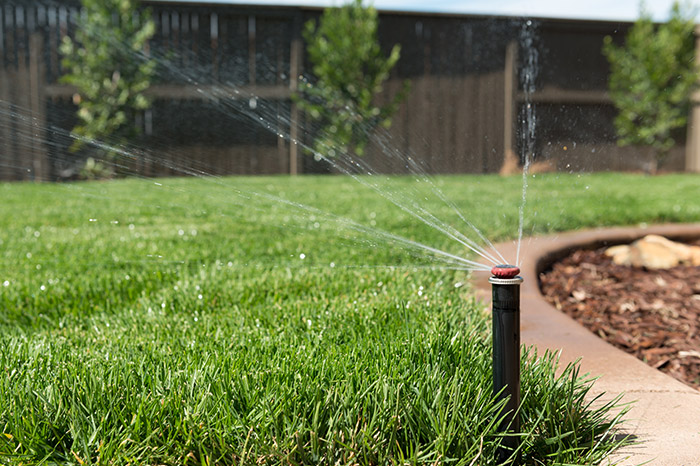
Landscape Cultural Practices to Save Water
Recently, our partner company Arborjet announced an exciting new partnership with Ecologel. Ecologel is a premier developer and manufacturer of innovative products for water conservation, dust mitigation, plant nutrition, pond and lake management, and anti-fungal coatings. This blog post was contributed by Ecologel’s Director of Agronomy Jim Spindler, CPAg, CCA, CPSS.
Water is a very important resource in today’s world. It is needed for all life and is used in many kinds of industries. Finding ways to use water more efficiently will greatly benefit our society. Some studies have shown that landscapes can use as much as 51% of a household’s total water. There are many cultural practices that can help people have beautiful landscapes while minimizing water use. Let’s discuss some best practices.
Right Plants, Right Place
The most efficient use of water in the landscape begins with selecting the right plants for the environment. Using native or drought tolerant varieties can significantly reduce irrigation requirements. Consult your agricultural extension office or other local experts for suggestions on the most water efficient plants for your area. In addition to selecting the right varieties, plants should be arranged based on their water needs. Placing turfgrass and flower beds on separate irrigation zones help minimize waste and avoid issues associated with over- or under-watering.
Use Good Grooming Practices
Proper plant grooming will help save water in the landscape. When cutting lawns, do not remove more than one-third of the leaf. This will allow the grass to recover with minimal stress. Stressed plants use more water. In addition, cut lawns higher, for example at 3 to 3 ½ inches. This allows the plant to do more photosynthesis which manufactures food for the roots and other parts of the plant. Longer grass helps shade the soil from the drying effects of the hot sun. Excess trimming of other plants, such as flowers, trees, and shrubs, can have the same effect and causes the plant to use more water trying to recover from the injury.
Grooming also includes thatch control and relieving soil compaction. Experts recommend that a lawn have up to ¾ of an inch of thatch. Thatch in lawns function much like mulch applied to flower beds. These will insulate the ground, preventing the soil from becoming excessively hot, causing the undue loss of water through evaporation. Excessive thatch or mulch can become hydrophobic, or water resistant, preventing rain or irrigation water from readily entering the soil.
Soil compaction is also an enemy of efficient water use. Like excessive thatch accumulation, compaction prevents rain and irrigation water from entering and recharging the soil. The soil acts like a sponge to absorb and hold water for the plant to use. If excessive thatch or soil compaction prevents water from entering the soil, then the plant struggles, causing it to look bad which many people interpret as a need for more water. It becomes a vicious cycle. There are machines that can relieve compaction through a process called aeration that pokes many holes in the soil.
Proper Nutrition is Important
Like people, plants need to be fed correctly to perform their best. Providing the right kinds of nutrients, like nitrogen, phosphorus, potassium, iron, and others, in the right proportions help plants use water in the most efficient manner. Just as too much sugar can cause a child to become hyperactive, excess nutrients, particularly nitrogen, can cause grass and other plants to become “hyper” as well. Excess nitrogen will promote much faster growth of plants, which requires more water than normal. Excessive growth will require more plant trimming or cutting of lawns. Not only is that more work for us, but causes excess injury to the plants, which will use more water to heal.
Soil pH affects the ability of plants to absorb nutrients from the soil. A soil test will identify if the soil is too acid or alkaline. This will help determine of the soil needs lime or other products to adjust pH. Many plants like a pH of 6 to 7 to optimize nutrient uptake, but check to see what pH is best for your local plants. When the pH is optimal, the plants are happy and functioning at their peak efficiency, which also optimizes the water use.
Technology Too!
There are many affordable technological advances to help the landscape be water wise. Rain sensors prevent an irrigation system from running in the rain or when there has been adequate rain. Soil moisture sensors help measure soil moisture and tell the irrigation system when water is needed. For more advanced systems, there is software that communicates with a local university or agricultural extension office that measures ET (Evapotranspiration), or the amount of water the daily weather causes plants to use. This software will tell the irrigation system how much water is needed so it can compensate for the water loss. Newer sprinkler heads are also designed for low water flow and to achieve the most even application of water in a landscape. Using irrigation timers to water late at night or early in the morning when it is cooler will avoid the unwanted evaporative loss of water experienced during the heat of the day. In additional to irrigation components, there are a number of soil applied products, such as hygroscopic humectants, which improve water efficiency in the landscape.
Join the Club
Efficient water use is possible in the landscape. There are all sorts of cultural practices and techniques that help in this effort. It is up to all of us to join in this effort. We can all have beautiful landscapes that minimize water use through utilizing all the tools we have available to us.
For more information, or to contact an expert, please visit www.arborjet.com.


Sorry, the comment form is closed at this time.